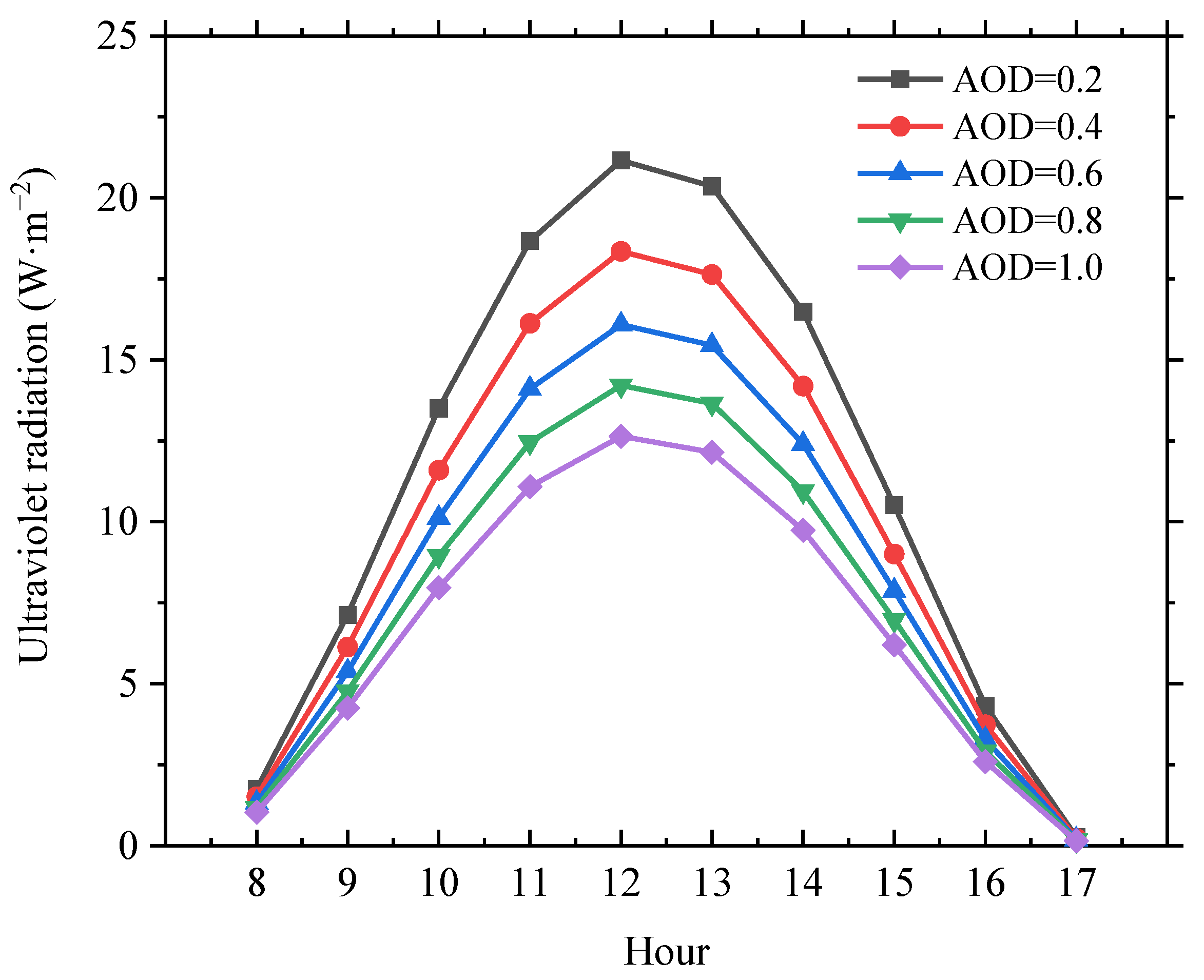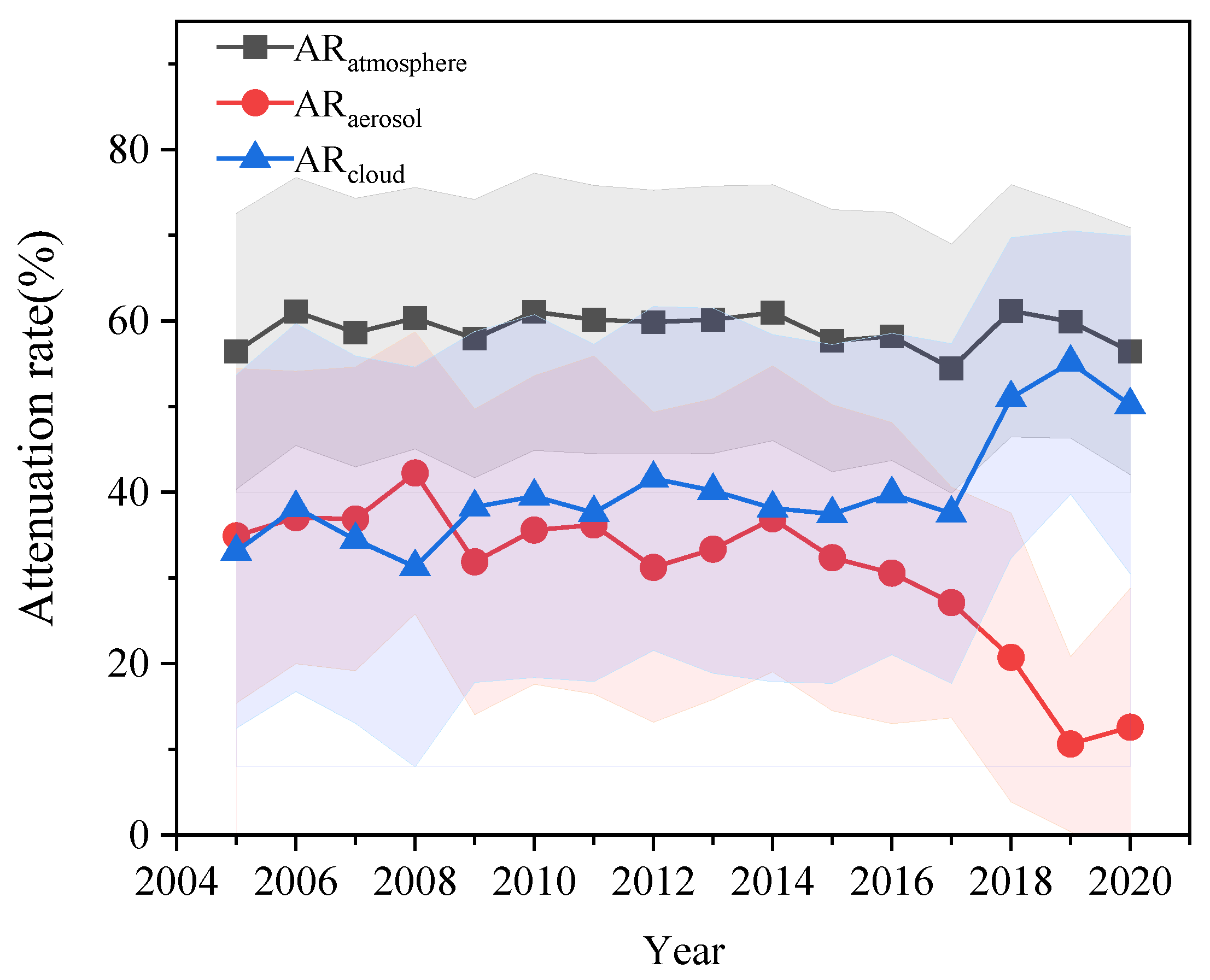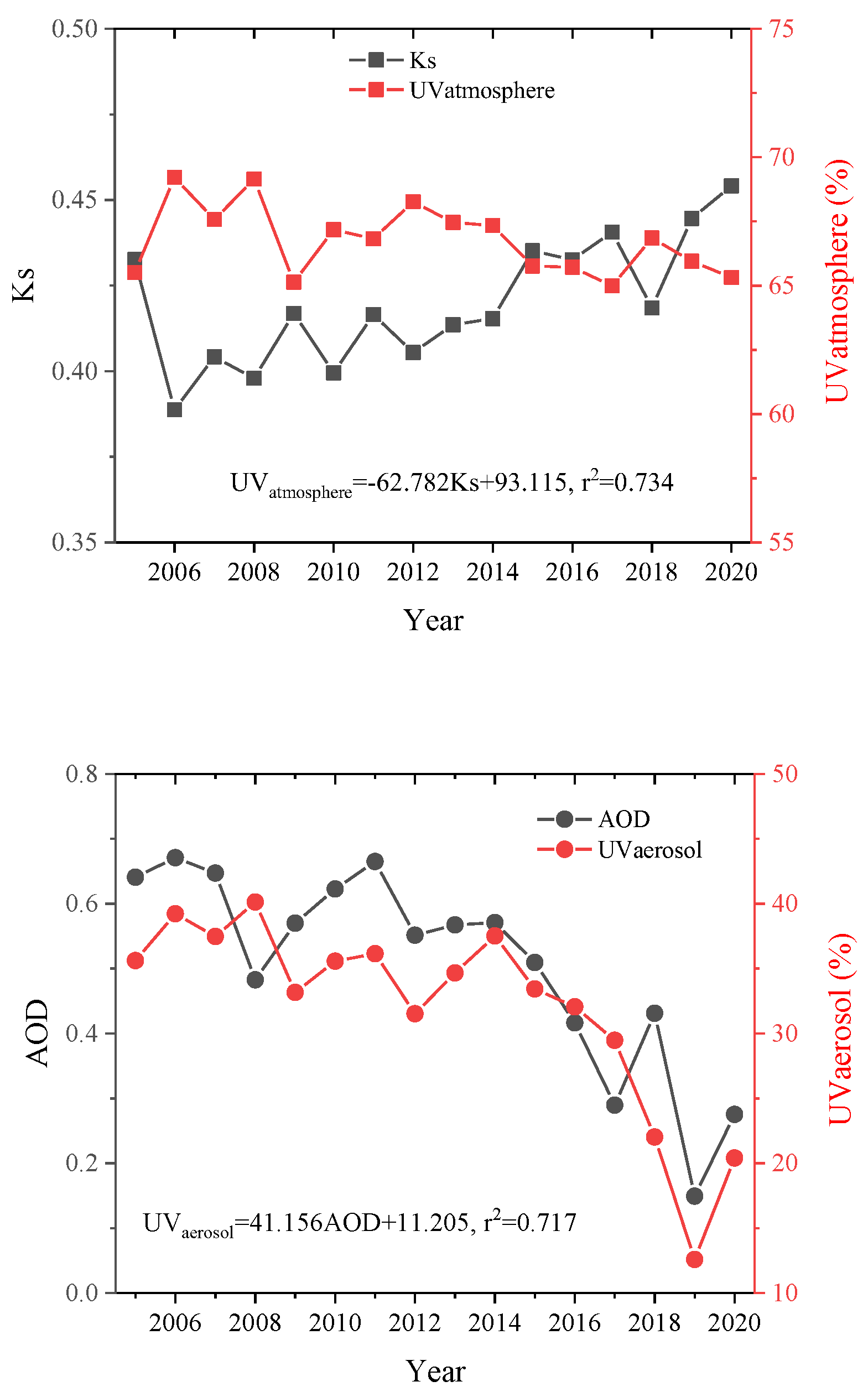Attenuation of Ultraviolet Radiation by Aerosols and Clouds in Beijing Area in 2005–2020
Abstract
:1. Introduction
2. Data and Methods
2.1. Observation Sites and Equipment
2.2. TUV Radiation Transfer Modes
2.2.1. Introduction to the Modes
2.2.2. Input Parameters
2.3. Attenuation Rate
3. Results
3.1. Sensitivity Analysis of UV Radiation
3.1.1. Sensitivity of UV Radiation to AOD
3.1.2. Sensitivity of UV Radiation to SSA
3.2. Attenuation of Ultraviolet Radiation by Aerosols and Clouds
3.2.1. Characteristics of Daily Variations in Aerosol and Cloud Attenuation of UV Radiation
3.2.2. Characteristics of Monthly Variations in the Attenuation of UV Radiation by Aerosols and Clouds
3.2.3. Characteristics of Annual Changes in Attenuation of UV Radiation by Aerosols and Clouds
4. Conclusions
- (1)
- UV radiation is negatively correlated with AOD and positively correlated with SSA; the sensitivity of UV radiation to AOD is greater than that of SSA.
- (2)
- Comparison of UV3 with UV1 shows that the annual averaged ARatmosphere is 56.46%, with the attenuation rate ranging from 54.47% to 61.17%; the monthly averaged attenuation rate is 59.72%, ranging from 54.57% to 64.85%; the daily average attenuation rate is 65.81%; and the overall fluctuation range is 63.95% to 70.69%.
- (3)
- Comparing the simulations of UV1 and UV2, it is found that the annual averaged attenuation rate, monthly average attenuation rate, and daily averaged attenuation rate of aerosol on surface UV radiation are 30.64%, 30.48%, and 31.02%, respectively, and the attenuation rate of aerosol on UV radiation is at a maximum at 8:00 (35.34%), followed by 9:00 (32.68%), and minimum at 12:00 (28.12%).
- (4)
- The attenuation effect of clouds on UV radiation is stronger than that of aerosols, and its annual averaged attenuation rate, monthly averaged attenuation rate, and daily averaged attenuation rate on UV radiation are 40.22%, 42.04%, and 50.45%, respectively.
Author Contributions
Funding
Institutional Review Board Statement
Informed Consent Statement
Data Availability Statement
Conflicts of Interest
References
- Bai, J.; Wang, G. Variation trends of solar UV radiation in Beijing during 1979–1996. Chin. J. Atmos. Sci. 1998, 22, 709–717. (In Chinese) [Google Scholar]
- Hu, B.; Wang, Y.; Liu, G. Variation characteristics of ultraviolet radiation derived from measurement and reconstruction in Beijing, China. Tellus B 2010, 62, 100–108. [Google Scholar] [CrossRef]
- Gueymard, C. The sun’s total and spectral irradiance for solar energy applications and solar radiation models. Sol. Energy 2004, 76, 423–453. [Google Scholar] [CrossRef]
- Kerr, J.B. Understanding the factors that affect surface ultraviolet radiation. Opt. Eng. 2005, 44, 041002. [Google Scholar] [CrossRef]
- Vieth, R. Critigue of the considerations for establishing the tolerable upper intake level for vitaminD: Critical need for revision upwards. J. Nutr. 2006, 136, 1117–1122. [Google Scholar] [CrossRef]
- Wu, T. Surface sunny ultraviolet radiation and biological effect. Meteorology 2021, 27, 54–57. (In Chinese) [Google Scholar]
- Peng, Q.; Zhou, Q. Ecological significance of enhanced UV-B radiation in secondary metabolism. Chin. J. Ecol. Agric. 2009, 17, 610–615. (In Chinese) [Google Scholar] [CrossRef]
- Browman, H. Assessing the impacts of solar ultraviolet radiation on the farly life stages of crustacean zooplankton and ichthyoplankton in marine coastal systems. Estuaries 2003, 26, 30–39. [Google Scholar] [CrossRef]
- Coakley, J.; Cess, R.; Yurevich, F. The effect of tropospheric aerosols on the earth’s radiation budget: A parameterization for climate models. J. Atmos. Sci. 1983, 40, 116–138. [Google Scholar] [CrossRef]
- Jerez, S.; Palacios-Peña, L.; Gutiérrez, C.; Jiménez-Guerrero, P.; López-Romero, J.M.; Pravia-Sarabia, E.; Montávez, J.P. Sensitivity of surface solar radiation to aerosol–radiation and aerosol–cloud interactions over Europe in WRFv3.6.1 climatic runs with fully interactive aerosols. Geosci. Model Dev. 2021, 14, 1533–1551. [Google Scholar] [CrossRef]
- Douglas, A.; L’Ecuyer, T. Quantifying variations in shortwave aerosol-cloud-radiation interactions using local meteorology and cloud state constraints. Atmos. Chem. Phys. 2019, 19, 6251–6268. [Google Scholar] [CrossRef]
- Li, Z.; Chen, H.; Cribb, M.; Dickerson, R.; Holben, B.; Li, C.; Lu, D.; Luo, Y.; Maring, H.; Shi, G.; et al. Overview of the East Asain study of tropospheric aerosols: An international regional experiment (EAST-AIRE). J. Geophys. Res. 2007, 112, D22S00. [Google Scholar] [CrossRef]
- Xia, X.; Chen, H.; Li, Z.; Wang, P.; Wang, J. Significant reduction of surface solar irradiance induced by aerosols in a suburban region in northeastern China. J. Geophys. Res. 2007, 112, D22S02. [Google Scholar] [CrossRef]
- Liu, J.; Xia, X.; Wang, P.; Li, Z.; Zheng, Y.; Cribb, M.; Chen, H. Significant aerosol direct radiative effects during a pollution episode in northern China. Geophys. Res. Lett. 2007, 34, L23808. [Google Scholar] [CrossRef]
- Ji, Y.; Wang, H.; Hu, Y.; Yang, T. Analysis of solar ultraviolet radiation variation characteristics and main influencing factors in Guiyang. Plateau Meteorol. 2011, 30, 1005–1010. (In Chinese) [Google Scholar]
- Ding, G.; Liu, C. Relationship between surface UV radiation and air quality in Hefei. Environ. Sci. Technol. 2014, 37, 378–381. (In Chinese) [Google Scholar]
- Deng, X.; Zhou, X.; Tie, X.; Wu, D.; Li, F.; Tan, H.; Deng, T. Attenuation of ultraviolet radiation reaching the surface due to atmospheric aerosols in Guangzhou. Chin. Sci. Bull. 2012, 57, 2759–2766. [Google Scholar] [CrossRef]
- Hu, B.; Wang, Y. The attenuation effect on ultraviolet radiation caused by aerosol and cloud in Lhasa, Tibetan Plateau of China. Adv. Space Res. Off. J. Comm. Space Res. (COSPAR) 2015, 56, 111–118. [Google Scholar] [CrossRef]
- Geiger, M.; Diabaté, L.; Ménard, L.; Wald, L. A web service for controlling the quality of measurements of global solar irradiation. Sol. Energy 2002, 73, 475–480. [Google Scholar] [CrossRef]
- System Description, AErosol RObotic NETwork. Available online: https://aeronet.gsfc.nasa.gov/new_web/system_descriptions.html (accessed on 30 July 2020).
- Madronich, S. Photodissociation in the atmosphere: 1. Actinic flux and the effect of ground reflections and clouds. J. Geophys. Res. 1987, 92, 9740–9752. [Google Scholar] [CrossRef]
- Ruggaber, A.; Dlugi, R.; Nakajima, T. Modelling radiation quantities and photolysis frequencies in the troposphere. Kluwer Acad. Publ. 1994, 18, 171–210. [Google Scholar] [CrossRef]
- Wang, S.; Su, W. Effect of atmospheric aerosols on UV-B radiation reaching the ground. J. Environ. Sci. 1993, 5, 224–229. [Google Scholar]
- Eck, T.F.; Holben, B.N.; Slutsker, I.; Setzer, A. Measurements of irradiance attenuation and estimation of aerosol single scattering albedo for biomass burning aerosols in Amazonia. J. Geophys. Res. Atmos. 1998, 103, 31865–31878. [Google Scholar] [CrossRef]
- Petters, J.L.; Saxena, V.K.; Slusser, J.R.; Wenny, B.N.; Madronich, S. Aerosol single scattering albedo retrieved from measurements of surface UV irradiance and a radiative transfer model. J. Geophys. Res. 2003, 108, 4288. [Google Scholar] [CrossRef]
- Wang, W.; Li, X.; Shao, M.; Hu, M.; Zeng, L.; Wu, Y.; Tan, T. The impact of aerosols on photolysis frequencies and ozone production in Beijing during the 4-year period 2012–2015. Atmos. Chem. Phys. 2019, 19, 9413–9429. [Google Scholar] [CrossRef]
- Lee, H.; Kim, W.; Lee, Y.G.; Kim, J.; Cho, H.K. Atmospheric Transmission of Ultraviolet and Total Solar Radiation by Clouds, Aerosols, and Ozone in Seoul, Korea: A Comparison of Semi-Empirical Model Predictions with Observations. Asia-Pac. J. Atmos. Sci. 2019, 55, 165–175. [Google Scholar] [CrossRef]
- Gao, W.; Gao, Q.; Chen, Y.; Ma, Z.; Gu, Y.; Li, W.; Li, W. Sandstorm event environment quality classification in Beijing. Resour. Sci. 2014, 36, 1527–1534. (In Chinese) [Google Scholar]
- Tang, L.; Hu, B.; Liu3, H.; Zhao, S.; Liu, J. Aerosol optical properties and direct radiative forcing in Beijing in the recent decade. Clim. Environ. Res. 2021, 26, 155–168. (In Chinese) [Google Scholar]









| Location | Period | UV Radiation | Attenuation | Reference |
|---|---|---|---|---|
| Beijing, China | 2005–2020 | 9.9 W·m−2 | 66.76% (by atmosphere) | This paper |
| Guangzhou, China | 2000, 2004, 2006 | 7 W·m−2 (monthly mean UVB) | 75% (by atmosphere) | Deng et al. [17] |
| Lhasa, Tibetan Plateau of China | 2005–2013 | 0.91 MJ·m−2·d−1 (annual) | 18% (by aerosols and clouds) | Hu et al. [18] |
| Seoul, Korea | March 2004 to February 2013 | 7.7 W·m−2 | 26% (by aerosols and clouds) | Lee et al. [27] |
Disclaimer/Publisher’s Note: The statements, opinions and data contained in all publications are solely those of the individual author(s) and contributor(s) and not of MDPI and/or the editor(s). MDPI and/or the editor(s) disclaim responsibility for any injury to people or property resulting from any ideas, methods, instructions or products referred to in the content. |
© 2024 by the authors. Licensee MDPI, Basel, Switzerland. This article is an open access article distributed under the terms and conditions of the Creative Commons Attribution (CC BY) license (https://creativecommons.org/licenses/by/4.0/).
Share and Cite
Zhao, S.; Xin, H.; Wu, S.; Sun, Y.; Hu, B. Attenuation of Ultraviolet Radiation by Aerosols and Clouds in Beijing Area in 2005–2020. Atmosphere 2024, 15, 311. https://doi.org/10.3390/atmos15030311
Zhao S, Xin H, Wu S, Sun Y, Hu B. Attenuation of Ultraviolet Radiation by Aerosols and Clouds in Beijing Area in 2005–2020. Atmosphere. 2024; 15(3):311. https://doi.org/10.3390/atmos15030311
Chicago/Turabian StyleZhao, Shuman, Huajian Xin, Shumin Wu, Yankun Sun, and Bo Hu. 2024. "Attenuation of Ultraviolet Radiation by Aerosols and Clouds in Beijing Area in 2005–2020" Atmosphere 15, no. 3: 311. https://doi.org/10.3390/atmos15030311
APA StyleZhao, S., Xin, H., Wu, S., Sun, Y., & Hu, B. (2024). Attenuation of Ultraviolet Radiation by Aerosols and Clouds in Beijing Area in 2005–2020. Atmosphere, 15(3), 311. https://doi.org/10.3390/atmos15030311







